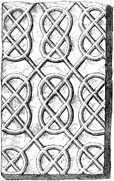Select a site alphabetically from the choices shown in the box below. Alternatively, browse sculptural examples using the Forward/Back buttons.
Chapters for this volume, along with copies of original in-text images, are available here.
Object type: Part of grave-cover(?)
Measurements: Dimensions as given by Davies (1926, 19): L. 38 cm (15 in) W. 20.25 cm (8 in) D. Not recorded
Stone type: Not recorded
Plate numbers in printed volume: Fig. 14; Ill. 351
Corpus volume reference: Vol 5 p. 255-256
(There may be more views or larger images available for this item. Click on the thumbnail image to view.)
The stone was a fragment from a flat, rectangular or slightly tapering cover decorated in low relief only on the upper surface. It had been recut for secondary use (Davies 1926, 19).
A (top): As engraved for Boutell (1854, 3; see Ill. 351), this face was occupied by three interconnecting lines of simple pattern F interlace in a repetitive figure-of-eight pattern. If the drawing in Boutell is true to scale, the figure-of-eight units were approximately 13 × 7.75 cm (5 × 3 in). Two rows of complete figure-of-eight are shown, together with a row of what appear to be free rings. The layout and spacing of the lines and rows are very regular. No border survived.
This stone is probably part of one of the interlace covers of Lindsey type discussed in Chapter V. It cannot be assigned with confidence and on direct evidence to either sub-group, since its border on three sides appears deliberately to have been removed. It is distinctive in its small scale. Assuming a typical border width, the cover's original width, if decoration was limited to three lines or registers of interlace as elsewhere, would have been of the order of 35cm (13.75 in). This is indistinguishable from the estimated width of Stow 1, assuming similar three-line decoration, and the figure-of-eight units are of closely similar size. Stow 1 and 2 might easily be from the same small-scale cover, which would rule out the alternative reconstruction discussed for Stow 1. The free rings, presumably at the foot end of the cover, find a direct parallel in this monument type on Northorpe 1 (Ill. 308). Stow 2 probably dates to the later tenth or the early eleventh century, the use of free rings plus the abnormal size both suggest later rather than earlier in the range.
The two or three similarly decorated stones (Stow 2–3) clearly provided the inspiration for the gable cross on St Mary's south transept, that dates from Atkinson's restorations.



